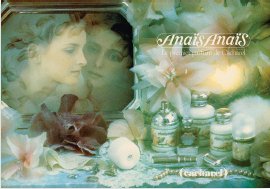Scent and Subversion (25 page)
Read Scent and Subversion Online
Authors: Barbara Herman

by Ralph Lauren (1978)
The misnamed Polo takes you deep into a magical olfactory forest of greens and woods. This classic men’s scent with unfortunate associations of popped-collared preppies (remember those?) is a Platonic Ideal of a men’s fragrance—or any fragrance, for that matter. It’s green and bracing, like a walk in cool woods, but it also has warmth and depth, even succulence, thanks to the addition of amber. As with Azurée, Estée Lauder’s oft-described “feminine” companion to the “masculine” Aramis, this momentary gourmand accord rounds out the perfume’s bitter and herbaceous qualities.
The leather in Polo is dirtier and darker than I remember it being, and as it dries down, the unmistakable waft of smoky campfire comes into play, signaling that one of
my favorite perfume notes—birch tar, a note that may soon be gone in perfumery altogether—must be part of the leather accord.
Top notes:
Juniper berry, artemisia, bergamot, cumin, basil, green note
Heart notes:
Pine needle, jasmine, carnation, geranium, thyme, rose
Base notes:
Patchouli, leather, moss, cedar, amber, musk, olibanum
by Jacomo (1978)
Perfumers:
Gérard Goupy and Jean-Claude Niel
Some women are scared of scents that are too green, or whose predominant notes include violet leaves, herbs, cut grass, or galbanum, a bitter aromatic gum resin that famously greened up Chanel No. 19, Bandit, and Vent Vert.
To those folks I say, I’m sorry; Silences is not going to change your mind. Silences by Jacomo is green to the extreme. With a bitter, herbaceous, and almost chalky galbanum beginning, Silences starts off with a tiny drop of sweetness from orange blossom, but then throws lemon and bergamot into the mix just so you know it’s not kidding around about this “green” business. (Galbanum resin is obtained from the Persian
Ferula gummosa
plant.)
A soft, powdery whisper of orris bridges the green with the delicate and clean florals of rose, lily of the valley, and jasmine. By the time it dries down, this austere beauty is delicately soapy, spicy, and soft all at once.
In Vent Vert, galbanum signaled the Rites of Spring, the rawness and near-savagery of things coming to life. In Chanel No. 19, as in Silences, galbanum suggests contemplation, stillness, and—well, silence. To some, Silences feels melancholic and pensive. I would add spooky. From its opaque, black, urn-like bottle to its name, which is a little deathly, Silences is something of a surreal perfume. It’s connected to life, with green notes and florals that signify renewal, yet it’s oddly disconnected from the familiar, a little uncanny.
Top notes:
Galbanum, bergamot, green notes, orange blossom, lemon
Heart notes:
Orris, jasmine, rose, lily of the valley, hyacinth
Base notes:
Moss, sandalwood, cedar, musk
by Jovan (1978)
Very similar to Estée Lauder’s Aliage, Sport Scent for Women starts off with a beautiful galbanum and neroli one-two punch (much like Aliage’s galbanum and peach), producing the nasal version of a pucker-inducing sour/sweet candy. Fresh, green florals sing at its heart, while a very “perfumey” base of moss, woods, and amber functions as the short
tennis skirt to feminize the scent that started out so bracing. An hour into the drydown, and all the hullabaloo of green dies down to a wonderful fresh and ambery warm base.
Top notes:
Galbanum, leafy green, bergamot, neroli, marjoram, angelica
Heart notes:
Orris root, hyacinth, rose, geranium, ylang-ylang, carnation, lily, jasmine
Base notes:
Sandalwood, musk, cedarwood, vetiver, oakmoss, amber, civet
by Estée Lauder (1978)
Perfumer:
Sophia Grojsman
There are some perfumes with names that perfectly align with your first impression of them. You almost wish you had been present at the creative meeting when all the great minds (and noses) converged—like directors, set designers, producers, costumers, and actors on a movie set before the shooting begins—to hash out the vision for the fantasy to come.
That’s what I feel about White Linen. The name itself is poetic, and immediately conjures up summer, heat, and the casual but chic fabric whose wrinkled, organic imperfections are at the heart of its charm. Bright yet warm, crisp but yielding to softness, White Linen has always been an olfactory puzzle for me. Even now, it’s hard to isolate the notes even as I read them and furiously sniff my wrists. Perhaps this is the effect of the powerful aldehydes, which work to abstract the notes to suit the perfume’s larger concept.
The same way that the sun and heat in summer can subsume a host of impressions (flowers, trees, grass, picnic, breeze, feelings, thoughts) into one blinding image or feeling, White Linen’s initial aldehydic blast blurs the individual notes.
It’s no surprise to me that Sophia Grojsman is the mind/nose behind White Linen. She is a magician at conjuring up not just beautiful scents and visual impressions, but also complex feelings associated with a perfume’s theme/concept.
When I smell White Linen, I smell the detergent that was used to wash the fabric and the smell of it vaporizing as it’s ironed. I can also smell the sun and the garden and perhaps the woods that surround the veranda I’m sitting on, drinking lemonade or a mint julep. But not many perfumers can add that extra dimension to a fragrance: mood, feelings, psychology. I’m not sure how she does it, but she’s a wizard.
Like a pointillist painting by Seurat, White Linen, if looked at up close, will yield its individual components. Its genius is that its first—and lasting—impression is what you’ll remember: crisp, laundered white linen on a beautiful summer day.
Top notes:
Aldehydes, citrus oils, peach, blossom-calyx note
Heart notes:
Rose, lily of the valley, jasmine, orris, ylang-ylang, lilac, orchid
Base notes:
Cedar, amber, sandalwood, civet, honey, benzoin, tonka

Perfume ads often paid lip service to the women’s movement and more-fluid gender roles, as in this 1975 example. At the same time, they also tried to make women feel insecure about their femininity—a problem easily remedied by perfume, of course.
by Cacharel (1979)

Cacharel hearkened back to the 1930s and ’40s for its fashion inspiration, and this 1986 ad for Anaïs Anaïs reflects that vintage influence.
Perfumers:
Roger Pellegrino, Robert Gonnon, Paul Léger, Raymond Chaillan
In its milk-white squat bottle featuring delicate pink flowers in a vintage design, Anaïs Anaïs was a perfume I liked as a teenager—fun and light while still being sophisticated. Described as a fresh floral by the
Haarmann & Reimer Fragrance Guide
, Anaïs Anaïs starts out with the signature 1970s combination of galbanum plus fruit. The sweetness from fruit is there, but just long enough to signal a lighthearted warmth; it soon recedes into the background, and Anaïs Anaïs moves on to transparent, delicate green florals.
Unlike the fruit bombs today that are marketed to young women, which translate “light and fun” into dreadful, fruity sweetness, Anaïs Anaïs doesn’t condescend to youth; it even provides a hint of chypre gravitas in the base. A sheer veil of Anaïs Anaïs stays on your skin long after you put it on.
Anaïs Anaïs ads reinforce the delicate personality of the perfume by featuring dreamy-looking women from another era, which perfume writer Brian Pera calls a soft-focus “reimagining of the erotica popular in the twenties.” Budding sexuality was respectfully represented as dreaminess. I wonder if we could ever get back to this ’70s euphemism and delicacy, or, in our pornified age, do we even want to?
Top notes:
Leafy green, bergamot, galbanum, fruit notes
Heart notes:
Jasmine, lily of the valley, rose, tuberose, ylang-ylang, orris
Base notes:
Cedarwood, sandalwood, vetiver, musk, moss, amber
by Paco Rabanne (1979)
Perfumer:
Robert Gonnon
Trained as an architect, fashion designer Paco Rabanne distinguished himself by using unusual materials like metal, plastic, and paper. He was prominent enough to have earned Coco Chanel’s scorn for his designs, including his space age–themed metal dresses made famous in
Barbarella.
“He’s not a couturier,” she sniffed, “but a metal worker.”
His perfume Mētāl is as innovative as his dresses. You’d think a perfume called Mētāl would be cold, steely, and harsh, but a surprise comes when you sniff this one: It’s a joyous, sheer floral, so light and fresh it feels like it’s going to float away into the ether at any moment. By highlighting the lightest, freshest facets from a field of flowers and marrying them with green and citrus notes, touched with basil, Mētāl is able to convey coolness without itself being cold. Its subtle chypre drydown, with salty vetiver and oakmoss, adds chic to a perfume that might otherwise seem too jejune. And unlike a dress made of metal, Mētāl doesn’t age; it smells completely modern.
Top notes:
Aldehydes, citrus oils, basil, hyacinth, green note
Heart notes:
Jasmine, lily of the valley, rose, tuberose, ylang-ylang, orris, cyclamen
Base notes:
Vetiver, sandalwood, amber, oakmoss, musk
by Guerlain (1979)
Perfumer:
Jean-Paul Guerlain
If you’ve ever left a red rose to dry somewhere, you’ll recognize the winey, rich scent, halfway between dried petals and a stewed fruit / mulled wine accord in Guerlain’s Nahéma. This dark honeyed rose gets a bit of wispy lightness from lilac, followed by an embrace of rich, waxy balsams and woods in the base.
Top notes:
Peach, bergamot, green notes, flower calyx note
Heart notes:
Rose, ylang-ylang, jasmine, lily of the valley, lilac
Base notes:
Peru balsam, tolu, benzoin, vanilla, styrax, vetiver, sandalwood
by Jean-Louis Scherrer (1979)
Scherrer 1, Jean-Louis Scherrer’s grand 1970s chypre, has the bitter, green, and slightly intimidating tough-lady air of Bandit, Cabochard, and later, Paloma Picasso’s homage to those bitch-on-wheels fragrances. Its haughty and austere character, however, is
tempered by a warmth in the drydown that adds an animalic, approachable softness that belies the tough-gal act.
Scherrer 1 is no perfume for an ingénue. Its florals are funky and indolic; its green notes, rather than being fresh, are bitter and bracing; its softness and warmth, provided by costus root (according to perfume historian Octavian Coifan), suggests unwashed hair, the sensuality of a woman who neglects herself, as the French say by way of a compliment.
Top notes:
Cassis, hyacinth, violet, aldehyde, green note
Heart notes:
Jasmine, tuberose, rose, carnation, orris, gardenia
Base notes:
Sandalwood, vanilla, musk, cedar, vetiver, amber, moss, civet

In this hilarious 1974 ad for Ambush, the word becomes a catchall phrase for the let-it-all-hang out ’70s.